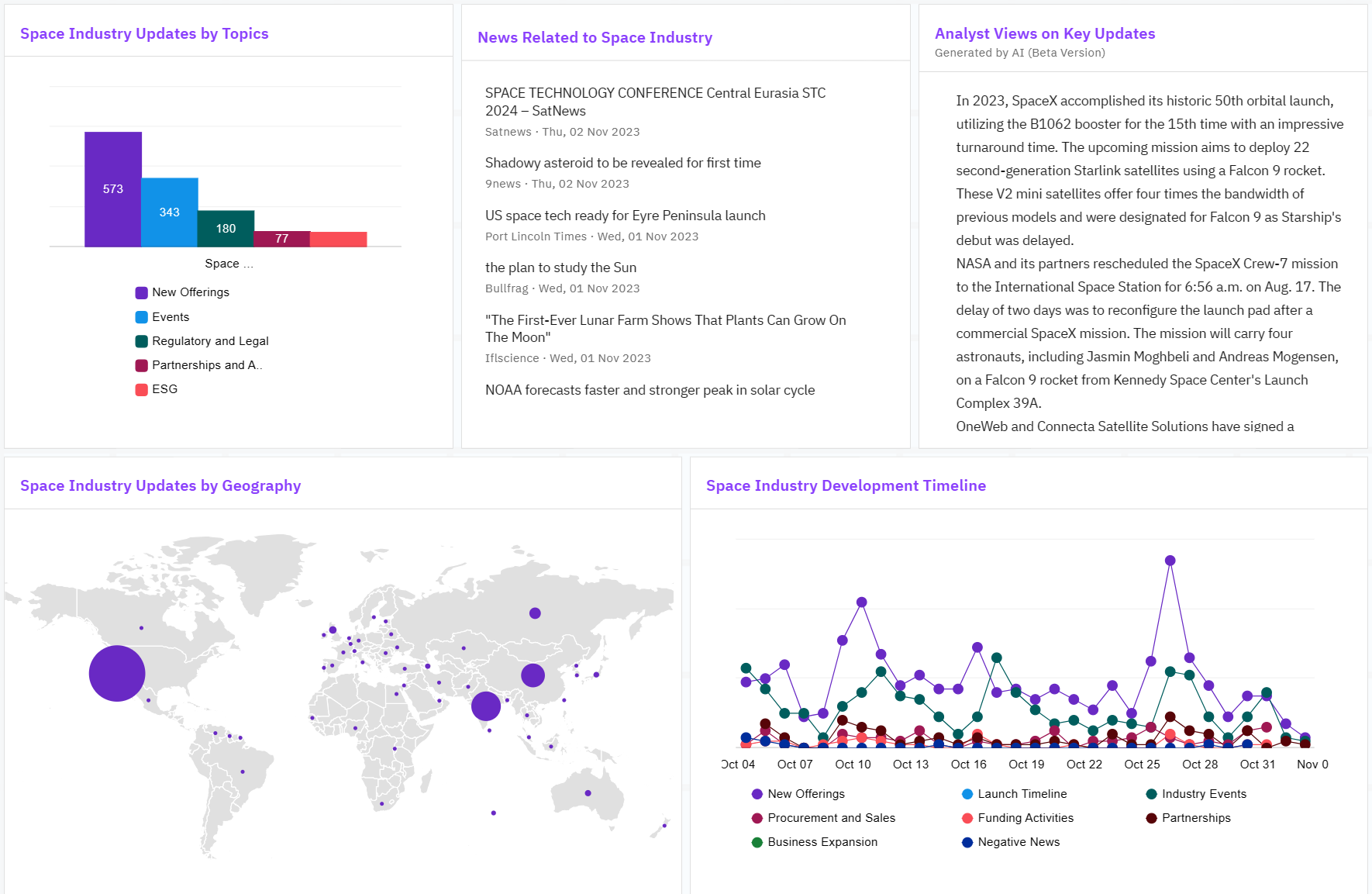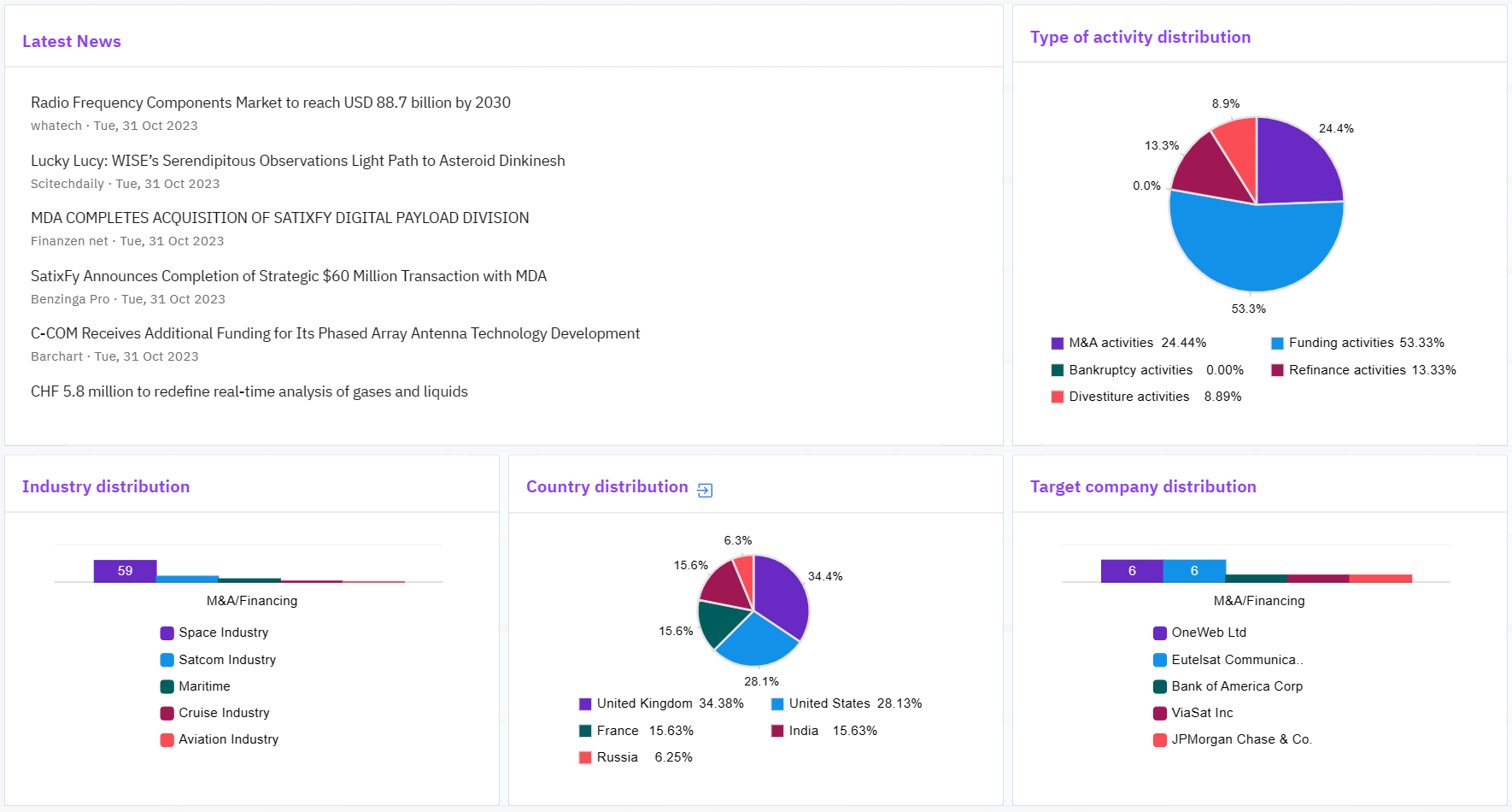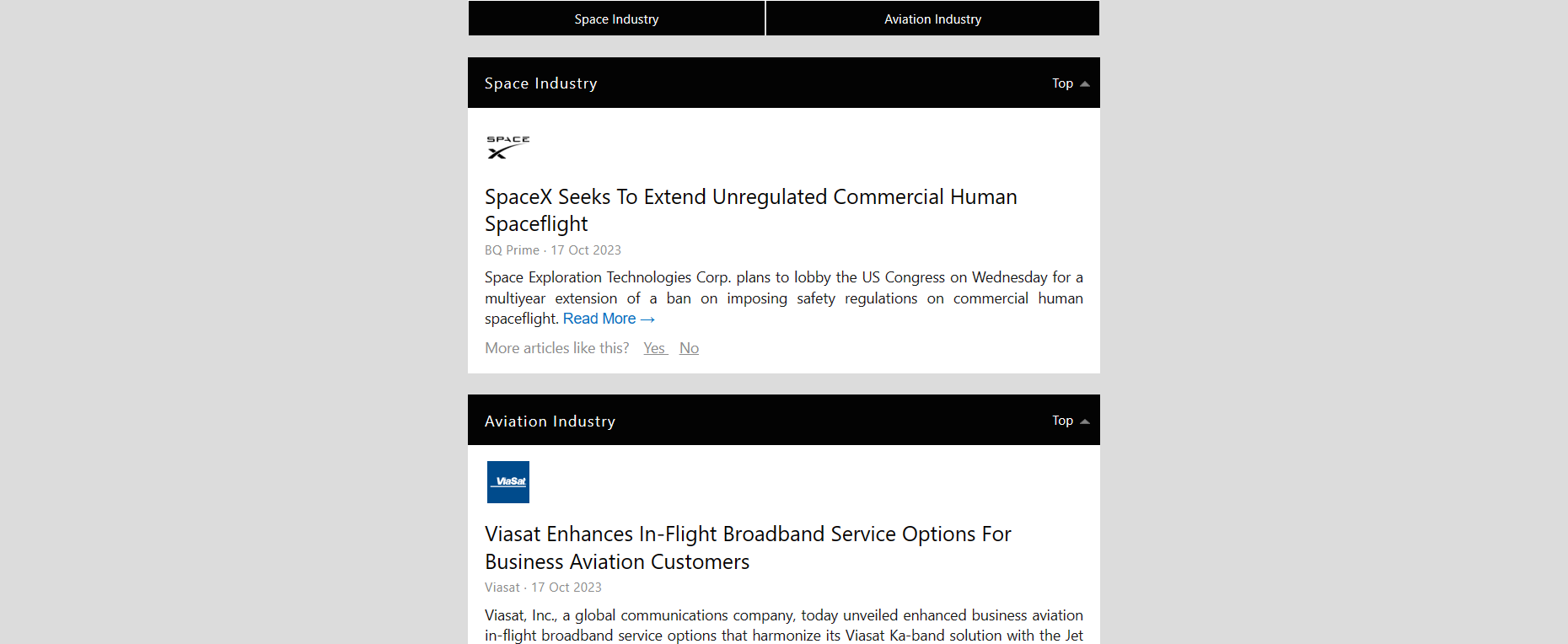Overview
The aerospace and satellite technology company’s objective was to anticipate and navigate market disruptions, geopolitical shifts, and emergent technological frontiers in the volatile space and defense landscape.
They wanted to improve their strategic decision support system, speed up tech innovation, and plan better for the future by utilizing targeted market and competitive information.
These market insights would help not just in responding quickly to market developments, but more importantly, in actively planning their business strategy in light of new developments. The company planned to use the competitive insights to develop strategic partnerships, and influence industry discussions, and establish them as an influential player in aerospace and satellite innovation.
Industry Overview
The satellite and aerospace industry is a powerhouse of technological innovation and strategic significance. This sector has a big financial setup with major investments in tech, people, and infrastructure. There are new partnership announcements, new innovations, and startups coming up frequently, making the industry dynamic, with constant changes.
Key companies like SpaceX, Blue Origin, and Lockheed Martin lead groundbreaking missions, marking a new chapter in space travel and exploration. They leverage smart resources and cutting-edge tech for missions ranging from launching low Earth orbit (LEO) satellites to interplanetary exploration.
This industry is instrumental in interconnecting our entire planet, deploying satellites that facilitate essential communication networks, GPS, and global internet coverage. Advanced aerospace technologies foster exploration, scientific discovery, and national security.
Business Objectives
Armed with a specialized market intelligence, the company embarked on a mission with precise, multi-faceted objectives to bolster its leadership in the aerospace and satellite sectors:
- In-depth Competitor Analysis: Aim to continuously monitor, analyze, and understand competitors’ strategies, technological advancements, and actions to maintain their competitive edge.
- Policy and Regulation Tracking: Keep abreast of evolving governmental policies, global regulations, and industry compliance standards that directly impact aerospace operations and strategies.
- Technological Advancements: Stay ahead by identifying and leveraging emerging technologies by tracking patents across different jurisdictions and enhancing their product and service offerings in alignment with futuristic market needs.
- Market Trend Identification: Develop a deep understanding of market trends, consumer expectations, and emerging sectors to direct their product and solution strategies effectively, ensuring relevance and leadership.
- Sales and Growth Strategy: Equip their sales teams with precise, timely intelligence on market needs, competitor moves, and industry innovations to effectively tailor their sales strategies for optimized outcomes.
- Strategic Partnership Scouting: Cultivate a focused approach to identify potential partnership opportunities, or strategic alliances that could bolster their positioning and expansion strategies.
Key Challenges
The Strategy and Market Intelligence Manager encountered several challenges while striving to achieve the above objectives set to reinforce their leadership in the aerospace, satellite, and space sectors:
- Redundancy Issues: Managing multiple streams of similar intelligence from various channels led to a redundancy, making data validation a repetitive and tiresome task.
- Sector-specific Intelligence Deficit: Generic information sources lacked the precision to yield sector-specific insights crucial for decision-making in specialized domains such as space, aviation, and maritime industries.
- Managing Unstructured Data: Analysts grappled with voluminous unstructured data, finding it challenging to efficiently organize, tag, and store information, resulting in analysis inefficiency and paralysis.
- Semantic Search Queries: The inability to write semantic search queries led to an influx of irrelevant data, hampering productivity and elongating the information gathering process.
- Requirement for Updated Intelligence: Given the industry’s dynamic nature, receiving timely and updated market intelligence was imperative to avoid reliance on obsolete information, ensuring strategies were formulated based on the most recent and relevant insights.
To overcome these hurdles, the decision was made to implement a Market & Competitive Intelligence platform. After evaluation of more than ten platform vendors, Contify was chosen for its comprehensive features that resonated well with the company’s business objectives.
Contify’s Solution
To address the complex and varied objectives of the satellite and aerospace company, Contify engineered a multi-faceted solution, which consisted of:
Semantic Search Queries
To cut through the noise and provide targeted intelligence, Contify developed custom search queries using semantic search parameters that prioritized information directly related to space, satellite, satcom, and defense sectors. This solved the ‘Search Specificity’ challenge the company faced.
Taxonomy and Tagging
Addressing the issue of unstructured data, Contify implemented a robust taxonomy and tagging system using its Taxonomy Manager, significantly enhancing data relevancy and retrieval. By categorizing and tagging data based on predefined parameters such as sectors, competitors, and strategic themes, a structured dataset was created.
This organization of data drastically reduced redundancy, enabled easier access to insights, and fostered a richer understanding of the evolving market dynamics.
Custom Sources
Contify has a proprietary crawling infrastructure. This means that any custom source can be crawled and updates from them can be included in the Contify platform. Harnessing information from custom sources is pivotal for precise intelligence. Contify enhanced data relevance by integrating custom sources tailored to the aerospace and satellite sector’s unique needs.
Proprietary crawling infrastructure was leveraged Contify crawling infrastructure has business context as well, hence the custom sources are crawled based on the publication frequency and geographic location of each source. This meticulous setup ensured a steady flow of timely and pertinent data, addressing the search specificity challenge further and significantly augmenting the value of the intelligence delivered to the company.
Customized Dashboards
One of the most impactful features, the customized dashboards catered to the unique specializations within the team. From monitoring macroeconomic updates to capturing company-specific growth updates, the dashboards were tailored to meet different departments’ intelligence needs.

Leveraging Contify’s GenAI capabilities, the dashboards also offered analysis and summaries of key market developments. This directly aligned with the business objectives of operational efficiency and strategic alignment while simultaneously conquering the challenge of unstructured data.

Intelligence Newsletters
Going beyond company-specific tracking, Contify’s solution also offered broader industry insights through Intelligence Newsletter Reports, like developments in NewSpace and investment trends in the space sector.

Primary Intelligence
To combat redundancy and leverage primary intelligence, Contify’s integrations with collaborative platforms like Slack, MS Teams, and email proved invaluable. These allowed seamless sourcing and sharing of primary intelligence from various internal discussions and communications.
By centralizing this invaluable internal knowledge, Contify not only eliminated repetitive efforts but also enriched the overall intelligence, making it a comprehensive repository of both external market updates and internal insights.
Impact
The integration of Contify’s tailored solutions had a multi-dimensional impact on the company’s market and competitive intelligence capabilities, as outlined below:
Strategic Enhancement
The actionable insights provided by Contify served as a linchpin for shaping the company’s go-to-market strategy, sales tactics, and marketing outreach.
The organization was able to leverage most updated market intelligence to build a roadmap that was both responsive to the evolving market and effective in outmaneuvering competitors. The reliability and depth of the information equipped the company’s leadership with fact-based intelligence for their strategic decisions.
Time Efficiency
One of the most immediate and tangible benefits was the drastic reduction in time spent on information gathering and curation. Automated features replaced what used to be a labor-intensive, error-prone process.
This newfound efficiency freed up invaluable time for the specialized team to focus on high-level, strategic initiatives that drive company growth and value.
Data Richness and Quality
The automated tagging features and advanced analytics of the Contify platform led to a marked improvement in the richness and reliability of the gathered data.
This not only fulfilled the original objective of transforming unstructured data into actionable insights but also empowered better decision-making across the board.
Cross-Departmental Benefits
Contify’s customized dashboards proved to be an invaluable asset for the different departments, including Strategy, Sales, and Marketing. The tailored intelligence helped each department take calculated, informed decisions, thereby acting as a catalyst for inter-departmental synergy.
Customer Testimonial
“The Contify platform has reformed how we approach market and competitive intelligence. It’s not just a tool; it’s an extended part of our strategic arm. From timely updates to in-depth analysis, it’s like having an extra team of analysts at your disposal.”
– Manager, Strategy and Market Intelligence






